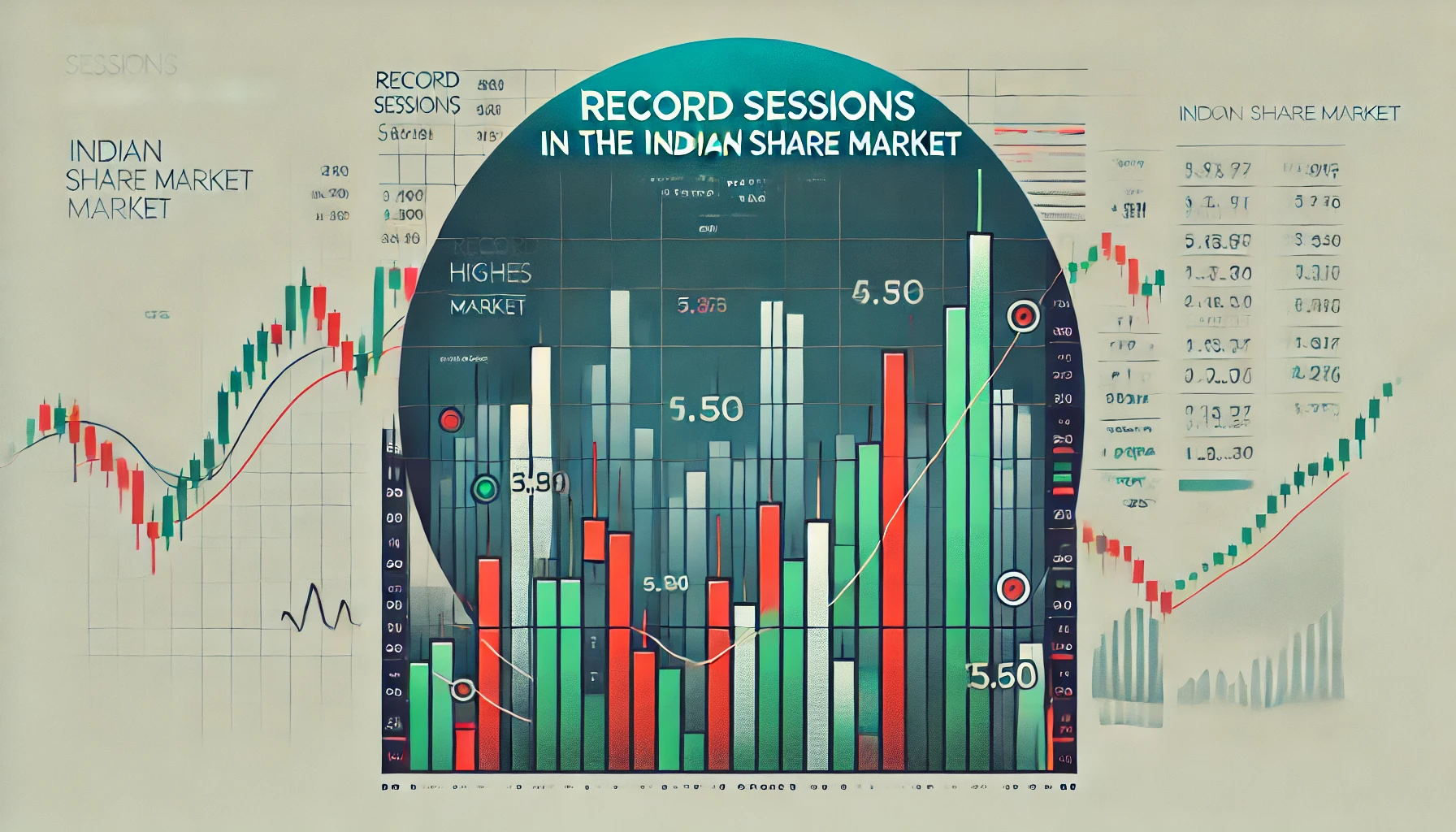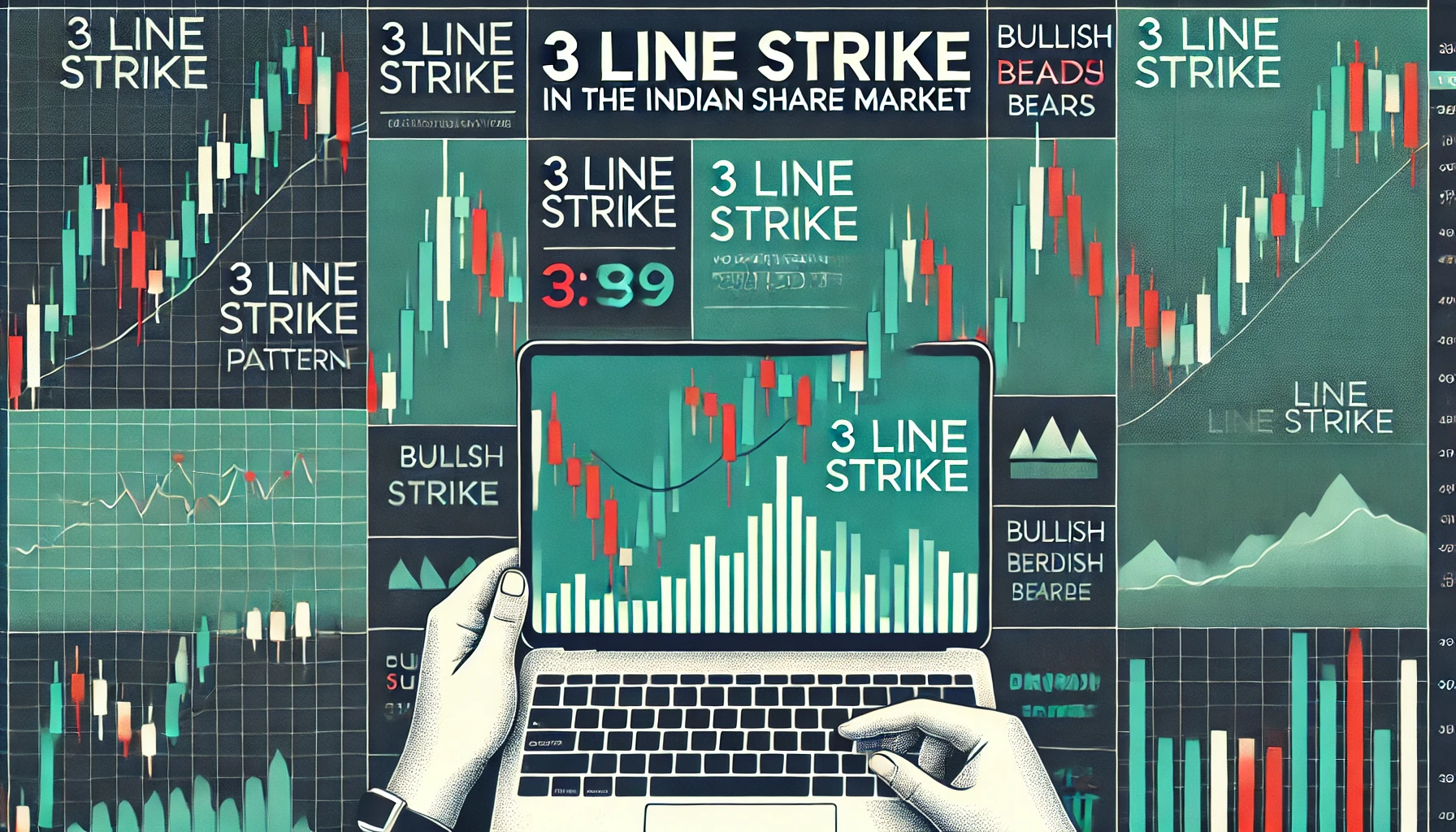Candlestick patterns play a crucial role in technical analysis, providing traders with valuable insights into market sentiment and potential price movements. Among these patterns, the Doji is one of the most significant as it often signals indecision in the market, which could precede a trend reversal or continuation. In the Indian share market, understanding Doji patterns can greatly enhance your ability to time trades effectively.
This blog will delve into the fundamentals of Doji candlestick patterns, their different types, and how to use them to improve your trading strategy. We’ll also look at historical data and examples to provide you with a practical understanding of how Doji patterns work in real-time market conditions.
What is a Doji Candlestick?
A Doji candlestick is formed when the opening and closing prices of an asset are virtually identical, resulting in a very small or nonexistent body. It signifies indecision among buyers and sellers, often leading to a pause in the market trend. Depending on the context in which it appears, a Doji can signal either a reversal or continuation of a trend.
The Doji pattern looks like a cross or plus sign on a candlestick chart, as the open and close prices are almost the same, while the upper and lower shadows (wicks) show the high and low of the trading session.
Types of Doji Patterns
There are four main types of Doji candlestick patterns that traders should be familiar with:
- Standard Doji: This is the basic Doji pattern, where the open and close prices are almost identical, and the wicks are relatively short. It signals market indecision.
- Gravestone Doji: In this pattern, the open and close prices are at the bottom of the candlestick, with a long upper wick. This suggests a potential bearish reversal when it appears in an uptrend.
- Dragonfly Doji: In contrast to the Gravestone Doji, the Dragonfly Doji has its open and close prices at the top of the candlestick, with a long lower wick. It indicates a potential bullish reversal when it appears in a downtrend.
- Long-Legged Doji: This pattern has long upper and lower wicks, reflecting extreme indecision in the market. It can indicate both a reversal and continuation, depending on the context.
How to Identify Doji Patterns
A Doji pattern can be identified by its small or nonexistent body and long or short wicks. Here’s how to recognize each type:
- Standard Doji: Look for a cross-like shape with almost no body.
- Gravestone Doji: The wick is long and only extends above the body.
- Dragonfly Doji: The wick is long and only extends below the body.
- Long-Legged Doji: Both upper and lower wicks are long, with little to no body.
Historical Example of Doji in Indian Stocks
Let’s take an example of Infosys stock to illustrate how Doji candlestick patterns can be used to spot potential reversals.
| Date | Open | Close | High | Low | Doji Type | Signal |
|---|---|---|---|---|---|---|
| 10th April 2023 | ₹1,500 | ₹1,500 | ₹1,520 | ₹1,480 | Standard Doji | Wait for breakout |
| 18th April 2023 | ₹1,480 | ₹1,480 | ₹1,550 | ₹1,470 | Gravestone Doji | Bearish Reversal |
| 25th April 2023 | ₹1,470 | ₹1,470 | ₹1,490 | ₹1,430 | Dragonfly Doji | Bullish Reversal |
In the table above, we can see how Doji patterns indicated potential market indecision and reversals in Infosys stock during April 2023. Traders could have used these signals to make more informed decisions about their trades.
Doji Patterns in the Indian Share Market
Doji patterns are particularly useful in the Indian share market, where volatility and trend changes can occur frequently. Traders can use these patterns to spot potential turning points in stocks, indices like the Nifty 50, or even sectors like IT or pharma.
Below is a table showing how Doji patterns appeared on the Nifty 50 index in recent months:
| Date | Open | Close | High | Low | Doji Type | Outcome |
|---|---|---|---|---|---|---|
| 1st March 2023 | ₹18,000 | ₹18,000 | ₹18,200 | ₹17,800 | Long-Legged Doji | Market Consolidation |
| 10th March 2023 | ₹18,150 | ₹18,150 | ₹18,300 | ₹17,900 | Gravestone Doji | Bearish Reversal |
| 20th March 2023 | ₹17,800 | ₹17,800 | ₹18,100 | ₹17,600 | Dragonfly Doji | Bullish Reversal |
In these examples, Doji patterns helped identify periods of indecision, followed by significant trend reversals.
How to Use Doji Patterns in Your Trading Strategy
Doji patterns can be used as part of a broader trading strategy, especially when combined with other technical indicators like Moving Averages, RSI (Relative Strength Index), or Bollinger Bands. Here are a few strategies you can adopt:
- Reversal Signals: Look for Doji patterns at the top or bottom of a trend. If a Doji appears after a strong uptrend or downtrend, it may signal a reversal.
- Breakout Confirmation: Wait for confirmation after the Doji appears. A strong bullish or bearish candlestick following the Doji can confirm the direction of the market.
- Combine with Other Indicators: Use Doji patterns alongside momentum indicators like RSI to get a better sense of whether the market is overbought or oversold.
Combining Doji with Other Indicators
Let’s look at how combining Doji patterns with the RSI indicator can provide more reliable signals for trading.
| Stock | RSI | Doji Pattern | Signal |
|---|---|---|---|
| HDFC Bank | 75 (Overbought) | Gravestone Doji | Bearish Reversal |
| Tata Motors | 30 (Oversold) | Dragonfly Doji | Bullish Reversal |
In this table, the combination of overbought/oversold conditions and Doji patterns helps traders make informed decisions about potential reversals.
Benefits of Using Doji Candlestick Patterns
- Indicates Market Indecision: Doji patterns are excellent at highlighting market indecision, helping traders stay cautious and wait for clear signals.
- Effective in Reversal Scenarios: When Doji patterns appear after a strong trend, they often signal a potential reversal, allowing traders to enter or exit trades at the right time.
- Works in All Market Conditions: Whether the market is trending or consolidating, Doji patterns can provide valuable insights into future price movements.
Limitations of Doji Patterns
While Doji candlestick patterns are useful, they are not foolproof. They are best used in conjunction with other technical indicators, as they only show indecision and not a guaranteed reversal. Furthermore, Doji patterns can occur frequently, especially in sideways markets, leading to false signals.
To mitigate these risks, traders should always look for confirmation before making a trade based solely on a Doji pattern.
Historical Performance of Doji Patterns in the Indian Share Market
To further illustrate the effectiveness of Doji patterns, let’s analyze how they performed during a significant market event, such as the COVID-19 crash in March 2020.
| Date | Nifty 50 Open | Nifty 50 Close | Doji Pattern | Outcome |
|---|---|---|---|---|
| 1st March 2020 | ₹11,800 | ₹11,800 | Long-Legged Doji | Market indecision, high volatility |
| 10th March 2020 | ₹11,000 | ₹11,000 | Gravestone Doji | Bearish continuation |
| 20th March 2020 | ₹8,800 | ₹8,800 | Dragonfly Doji | Bullish Reversal, recovery |
The table shows how Doji patterns highlighted key points of indecision and reversals during a highly volatile market period.
How to Implement Doji in Your Trading Strategy
If you’re looking to integrate Doji patterns into your trading strategy, here are some actionable steps:
- Look for Doji at Key Levels: Focus on finding Doji patterns near support and resistance levels, where the market is likely to reverse.
- Wait for Confirmation: Don’t trade solely on a Doji. Wait for a candlestick that confirms the market’s direction after the Doji appears.
- Use Other Indicators: Combine Doji patterns with technical indicators like Moving Averages or RSI to confirm the signal.
- Backtest Your Strategy: Backtest your strategy using historical data to ensure its effectiveness before applying it in live trading.
Conclusion
Doji candlestick patterns are powerful indicators of market indecision and can signal potential reversals or continuations in the Indian share market. By understanding the different types of Doji patterns and combining them with other technical indicators, traders can make more informed decisions about market entry and exit points.
Whether you’re a short-term trader or a long-term investor, integrating Doji patterns into your trading strategy can help you better navigate the dynamic conditions of the Indian share market.

What is the TRIN stock market indicator?
The TRIN (Trading Index), also referred to as the Arms Index, is a technical analysis …

Record Sessions
The Indian share market is a dynamic and volatile space where major highs and lows …

3 Line Strike
Candlestick patterns are a vital tool for traders in the stock market, offering insights into …

3 White Soldiers and 3 Black Crows
Candlestick patterns are a key element of technical analysis in stock trading, offering clear signals …

Gapping Doji
Candlestick patterns are a critical part of technical analysis in the stock market, providing traders …

3 Windows
Candlestick patterns are a vital part of technical analysis, offering traders and investors insights into …

2 Gapping Candles
In the fast-paced world of the Indian stock market, technical analysis plays a crucial role …

3 Inside Down and Up
Candlestick patterns are powerful tools in the world of technical analysis, offering traders insight into …

Bullish and Bearish Belt Hold
Technical analysis is an essential part of trading in the Indian share market. Candlestick patterns, …

Piercing and Dark Cloud Cover
In the ever-evolving Indian stock market, candlestick patterns are crucial for traders aiming to predict …

Double Doji
Candlestick patterns have long been a favored tool for technical traders to forecast market movements. …

Rising and Falling Windows
In the world of technical analysis, candlestick patterns are vital tools for traders to anticipate …

Tweezer Top and Bottom
In the fast-paced world of the Indian share market, traders use technical analysis tools to …

Morning Star and Evening Star
In the Indian share market, technical analysis is a valuable tool for traders aiming to …

Hammer and Hanging Man
The Indian stock market offers a wealth of opportunities for traders who understand technical analysis. …

Shooting Star and Inverted Hammer
The Indian stock market, with its dynamic nature, presents various opportunities for traders and investors. …

Last Engulfing
The Indian share market is filled with patterns that can help traders make informed decisions. …

Harami
In the world of stock market analysis, candlestick patterns offer valuable insights into price movements. …

Engulfing
The Indian share market is known for its volatility, and traders often rely on technical …

Marubozu
Candlestick patterns are powerful tools used by traders in the Indian share market to analyze …

Spinning Top
The Indian share market, like any other, experiences constant fluctuations due to a multitude of …

Doji
The Indian share market is dynamic, with investors using various tools to gauge stock performance. …

Double Top
In the world of technical analysis, chart patterns are valuable tools that help traders spot …

Tweezer
In the Indian share market, where volatility and price fluctuations are part of daily trading, …

Harami
In the world of technical analysis, candlestick patterns are powerful tools that help traders make …

Heiken-Ashi
Navigating the Indian share market can be challenging due to the inherent volatility and market …

Ichimoku
In the world of technical analysis, few indicators offer the comprehensive insights that the Ichimoku …

Value Charts
In the ever-changing landscape of the Indian share market, traders and investors need tools that …

Money Flow Index
In the Indian share market, identifying trends, understanding momentum, and assessing volume are critical components …

Aroon
In the fast-paced world of the Indian share market, identifying market trends and spotting reversals …

Gator Indicator
In the Indian share market, success is largely dependent on identifying the right trends and …



















